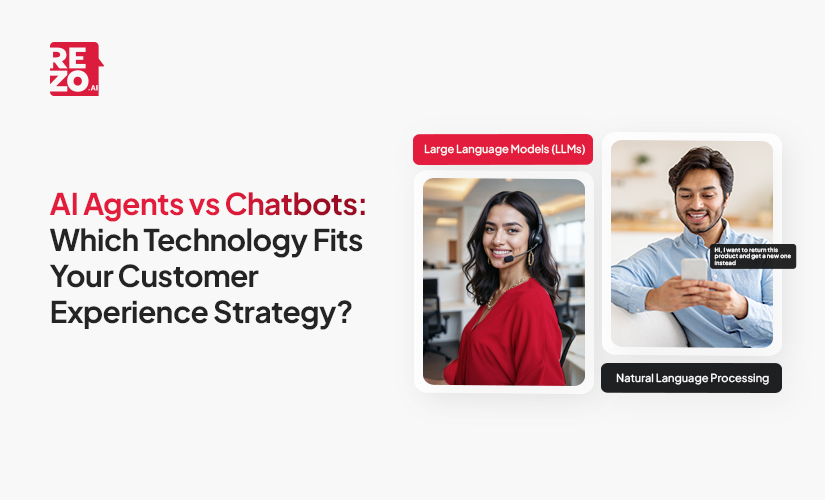
AI Agents vs Chatbots: Which Technology Fits Your Customer Experience Strategy?
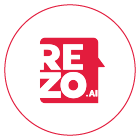
AI Agents vs Chatbots: Which Technology Fits Your Customer Experience Strategy?

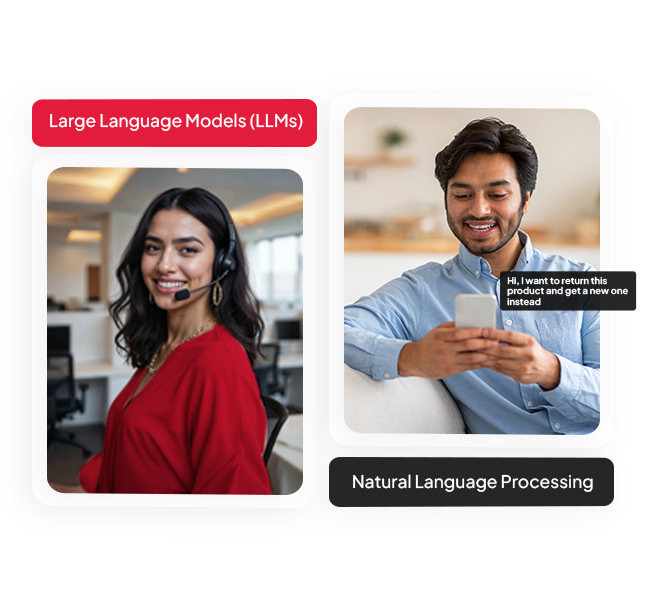
The customer service landscape has evolved dramatically from simple “Can I help you?” prompts to sophisticated systems that autonomously solve complex tasks. But with this evolution comes confusion, especially around the difference between AI agents and chatbots.
If you’re a CX leader evaluating customer service technology, you’ve likely encountered both terms used interchangeably. They’re not the same, and understanding the distinction is critical to making the right investment for your organization. The wrong choice could mean wasted resources, compromised future interactions with customers, frustrated customers, and missed efficiency gains.
In this article, we’ll cut through the marketing hype and examine what separates AI agents from customer service chatbots. More importantly, we’ll help you determine which technology, whether AI Agents or AI chatbots or a hybrid model fits your customer service strategy.
What's the difference between an AI Agent and a Chatbot?
Before diving into differences, let’s establish clear definitions. The terminology matters because vendors often use these terms loosely, creating confusion in the market.
What are Chatbots?
Chatbots are software applications designed to simulate human conversation through text or voice. Traditional chatbots operate on rule-based systems where developers define decision trees:- if a customer query says X, respond with Y. They excel at handling structured, predictable interactions.
Modern AI-powered chatbots have evolved beyond simple keyword matching. They use natural language processing to understand intent and can handle more nuanced queries. However, they still fundamentally operate within predefined conversational flows, providing information and routing requests rather than taking autonomous action.
Think of chatbots as knowledgeable assistants who can understand human language, answer questions and guide customers through established processes, providing consistent and reliable support. They’re reactive systems, waiting for customer input before responding within their programmed parameters.
What are AI Agents?
AI agents represent a fundamental shift in capability and autonomy. Rather than simply responding to queries, AI agents are goal-directed systems that can plan, reason, and execute multi-step workflows independently.
Powered by large language models (LLMs), and new gen technologies like generative AI and Agentic AI, AI agents understand user input, make decisions, and take actions across multiple systems to achieve specific objectives. They don’t just tell you how to solve a problem. They solve it for you by integrating with your tools, databases, and business systems.
Modern contact centers today can autonomously handle complex customer service scenarios from start to finish. The difference isn’t just technological, it’s transformational for how customer support operates.

What are the differences between AI Agents and Chatbots?
Understanding the conceptual distinction is one thing. Let’s examine the practical differences that impact your customer service operations.
Autonomy and Decision-Making
Chatbots are reactive:- they need a human trigger to start working. You ask a question, they provide an answer. You request information, they retrieve it and complete tasks. The conversation follows paths developers anticipated and programmed.
AI agents are proactive:- Agents work autonomously within defined parameters. They can initiate actions, make decisions based on context, process data, and adjust their approach when initial strategies don’t work. According to Gartner, at least 15% of day-to-day work decisions will be made autonomously through agentic AI by 2028, up from essentially 0% in 2024
Intelligence and Reasoning Capabilities
Chatbots use pattern matching and predefined logic. Even AI chatbots primarily select from pre-configured responses or retrieve information based on recognized intents. They’re sophisticated but ultimately limited to scenarios their creators anticipated.
AI agents employ reasoning capabilities that allow them to make informed decisions without any human input. They can operate independently, break down complex problems, consider multiple factors, weigh trade-offs, and devise solutions on the fly. This isn’t just semantic, it fundamentally changes what’s possible in customer service.
The implications are significant. While chatbots excel at answering “What’s your return policy?” or “Where’s my order?”, AI agents can handle “I received the wrong size, but I need this for an event tomorrow. What are my options?” by considering inventory, shipping logistics, store locations, and customer history to propose and execute the best solution.
Tool Integration and Action Execution
This is perhaps the most critical operational difference.
Chatbots can fetch information from databases and APIs, but they primarily deliver information to customer support agents who then take action. Their primary interface is the conversation itself.
AI agents integrate with your entire technology ecosystem to perform tasks. They can update CRM records, process refunds, schedule appointments, create support tickets, trigger workflows in other systems, and coordinate multi-step processes across multiple channels.
Consider a scenario where a customer receives a damaged parcel:
A chatbot might gather information and create a ticket for a human agent. AI chatbots can further resolve the customer inquiry, by providing pre-defined solutions for the problem.
An AI agent verifies the order in your e-commerce system, initiates a replacement shipment through your logistics platform, processes a refund through your payment system, updates the CRM with interaction details, and sends confirmation through the customer’s preferred channel, completing the entire resolution workflow autonomously and enhancing customer engagement significantly..
Memory and Context Awareness
Chatbots typically have limited memory, often confined to the current session. They might remember what you said three messages ago but not what you discussed last week. Each conversation essentially starts fresh.
AI agents maintain context across sessions and interactions. They remember customer history, previous issues, past interactions, preferences, and patterns. This persistent memory enables truly human like conversations, personalized services and allows agents to proactively address potential issues before customers even report them.
This capability becomes increasingly valuable as customer journeys grow more complex and require factors like emotional intelligence from the AI bots. Different types of AI agents can specialize in various aspects of the customer journey while maintaining shared context, ensuring seamless experiences even as customers move between channels (messaging apps) and touchpoints.
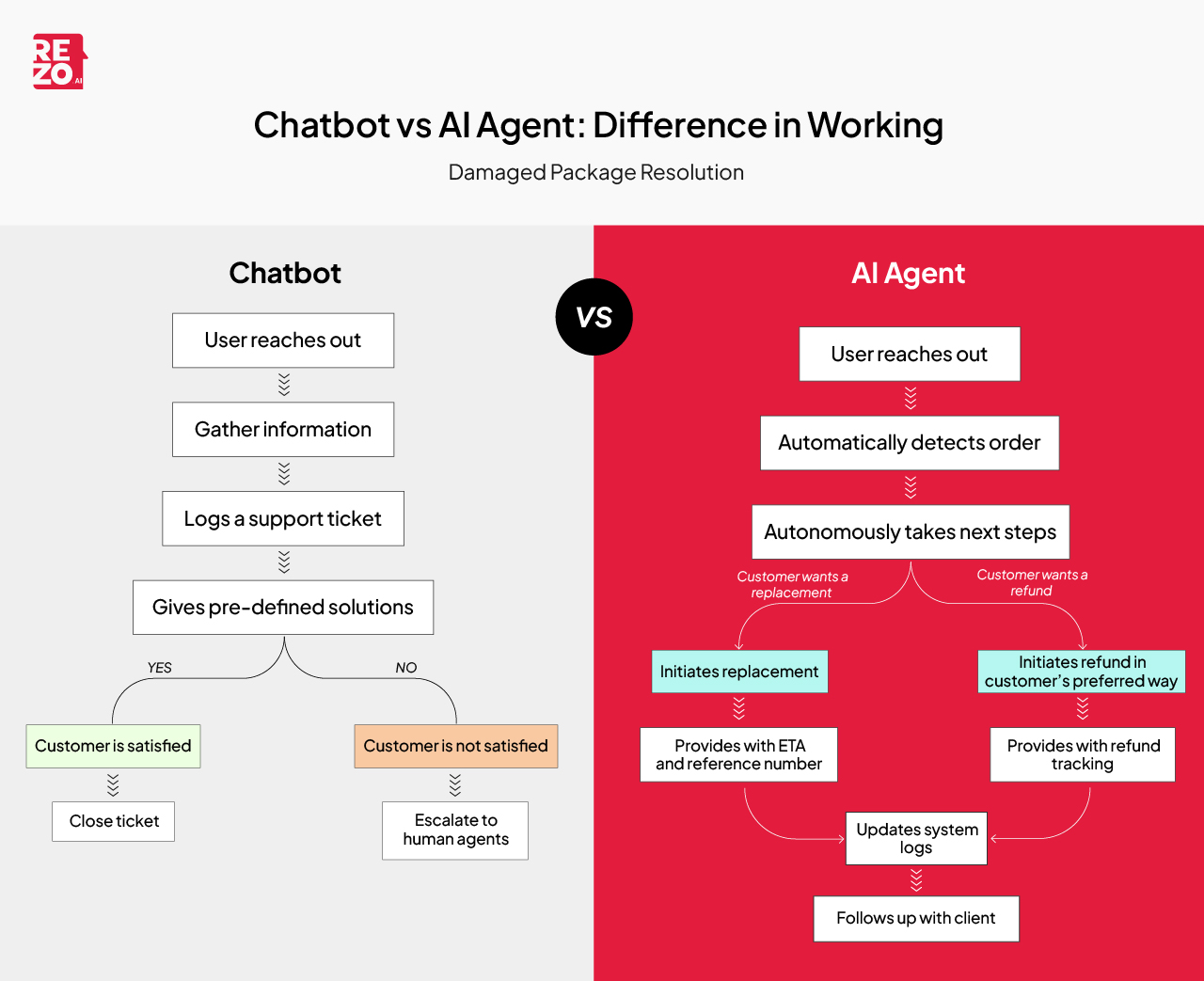
AI Agents vs Chatbots: Impact in Productivity
Theory is valuable, but what does the actual performance data tell us?
Chatbot Performance Benchmarks
Chatbots have proven themselves highly effective for specific use cases. Research shows that well-implemented chatbots resolve approximately 90% of queries in under 11 messages, impressive for structured interactions and repetitive tasks.
They excel particularly in high-volume, low-complexity scenarios: FAQs, basic account information, simple transactions, and routine status checks. For organizations receiving thousands of similar queries daily, chatbots deliver quick and accurate responses providing a positive customer experience.
The limitations become apparent with complexity. When conversations require multiple systems, personalized communication style, nuanced decision-making, context from previous interactions or deviation from anticipated paths, chatbots either fail or require human expertise.
Service representatives still spend a huge portion of their time on non-customer-facing tasks, often handling escalations from chatbot interactions.
AI Agent Performance Impact
The performance data for AI agents shows a different pattern. Organizations implementing AI-enabled customer service agents reported significant increase in issue resolution per hour and reduction in time spent handling issues, according to industry research..
The efficiency gains extend beyond speed. Companies deploying AI assistants expect a 10-20% decrease in canceled orders and measurable improvements in customer experience ratings.
Perhaps most striking is Gartner’s projection that by 2029, agentic AI models will autonomously resolve 80% of common customer service issues without human intervention, leading to a 30% reduction in operational costs.
These aren’t incremental improvements. They represent a fundamental shift in customer service economics. Agentic AI platforms are demonstrating how these efficiency gains translate directly to bottom-line impact for CX leaders.
Real-World Applications: When to Use Each
The “which is better” question misses the point. The right question is “which fits your specific use cases?” Let’s explore where each technology delivers optimal value.
When to use Chatbots?
Chatbots remain the optimal choice for several common scenarios:
- High-Volume FAQ Management: When you receive thousands of similar questions daily including questions about business hours, shipping costs, account balance checks, etc, chatbots handle these efficiently and cost-effectively.
- Initial Contact Screening: As a 24/7 first point of contact, chatbots can gather information, qualify inquiries, and route complex issues to appropriate resources, significantly reducing wait times.
- Simple Transactional Tasks: Routine tasks like basic account updates, appointment scheduling within defined parameters, and straightforward information retrieval work excellently with chatbot technology.
- Budget-Conscious Implementation: For organizations with limited resources or those just beginning their AI journey, chatbots provide an accessible entry point with clear ROI and manageable implementation complexity.
The key is matching chatbot deployment to their strengths like structured, predictable, high-volume interactions where the response patterns are well-defined.
When are AI Agents used?
AI agents deliver transformational value in different contexts:
- Complex Multi-Step Processes: When resolution requires coordinating across multiple systems including checking inventory, processing returns, updating accounts, scheduling follow-ups sophisticated AI agents execute these workflows autonomously.
- Personalized Customer Journeys: AI agents leverage customer history, preferences, and behavioral patterns to deliver truly personalized customer experiences that chatbots can’t replicate.
- Proactive Service Delivery: Rather than waiting for customers to report issues, AI agents can identify potential problems from data patterns and take preventive action, thus reducing customer churn rate and increasing customer loyalty.
- Cross-System Orchestration: In enterprises with complex technology stacks, Custom AI agents act as intelligent coordinators, executing actions across CRM, ERP, support platforms, and custom applications.
- Escalation Reduction: By handling nuanced situations that would typically require human intervention, AI agents resolve more issues on first contact and reduce the burden on your human team.
The business case for AI agents grows stronger as your customer service operations become more complex and your efficiency requirements more demanding.
AI Agents vs Chatbots: Adoption Trends and ROI
The conversation between chatbots and AI agents isn’t just theoretical, it’s driving significant investment and transformation across industries.
Market Growth and Investment
The adoption curve for AI agents is remarkably steep. Salesforce reports that with AI Agent deployment, 83% of sales team saw revenue growth and 92% of service team says AI reduces their costs.
Cost Savings and Efficiency Gains
The financial case extends beyond technology trends. Organizations face real pressure to improve efficiency while maintaining or enhancing service quality. Current statistics reveal significant waste in traditional models, salespeople spend their a lot of their time on non-selling tasks, while service representatives spend their time on non-customer-facing activities
AI agents address this directly by automating routine work, enabling human agents to focus on complex, high-value interactions. The projects significant reduction in operational costs by 2029 represents substantial savings for contact centers operating on tight margins.
For CX leaders evaluating ROI, platforms like Rezo.ai demonstrate how agentic AI delivers measurable improvements in first-call resolution, average handle time, and customer satisfaction scores, metrics that directly impact both costs and revenue.
AI Agents vs Chatbots: Which one to choose?
With clear differences and compelling data established, how should you approach the decision for your specific organization?
Assessment Framework
Start with an honest evaluation of your current state and requirements:
- Query Complexity Analysis: Audit your customer interactions. What percentage are simple, structured queries versus complex tasks, multi-step issues? High percentages of simple queries favour chatbot implementation; significant complex interaction volume justifies AI agent investment.
- Technology Maturity: Assess your existing systems. Do you have integrated platforms with accessible APIs? Can you support the infrastructure requirements for AI agents? Sometimes chatbots make sense as an interim step while building technical capabilities.
- Resource Availability: Consider both financial and human resources. AI agents typically require larger initial investment but deliver greater long-term efficiency. Chatbots offer quicker deployment with more modest upfront costs.
- Customer Expectations: What do your customers expect? In industries where speed and convenience trump personal touch, autonomous AI agents deliver competitive advantage. Intelligent systems can provide human like responses that are context aware and personalized to the customer.

AI Agents vs Chatbots: Which one to Implement?
Most successful organizations don’t view this as an either-or decision. The optimal approach often combines both technologies strategically.
Start with AI chatbots for high-volume, routine tasks, building AI literacy within your organization and establishing foundational automation. As you mature, deploy AI agents for increasingly complex scenarios, creating a tiered service model with multiple AI agents that matches technology capability to interaction complexity. Additionally you can build custom AI agents, assigning individual agents to a particular task, thus improving response accuracy.
You can explore various CX automation platforms that support both chatbot and AI agent capabilities, allowing you to evolve your approach without replacing your entire technology stack.
The change management aspect deserves attention. Your human team need training, reassurance about their evolving roles, and clarity about how external tools like AI chatbots or AI agents work to assist them and not to replace them. The most successful implementations position AI as empowering human agents to focus on more rewarding, complex work.
The Future: Beyond the Bot vs Agent Debate
Looking ahead, the distinction between chatbots and AI agents may blur as technologies converge. The more relevant question becomes: How do we create seamless customer experiences using the right mix of automation and human touch?
The data suggests customers care less about the technology and more about outcomes. Industry reports show more than half of the consumers don’t care how they interact with a company, as long as their problems are fixed fast. This outcome-focused perspective should guide your strategy.
The artificial intelligence evolution isn’t about replacing human agents, it’s about augmentation. Agentic AI for customer service enables human agents to handle higher-value interactions while automation manages routine work. This hybrid model improves both efficiency metrics and job satisfaction.
The opportunity for CX leaders in 2025 and beyond lies in thoughtfully orchestrating technology and human capabilities. Organizations that master this balance, deploying chatbots where they excel, leveraging AI agents for complex automation, deploying multi agent systems for accurate responses and empowering human agents with AI assistance will define the new standard for customer experience.
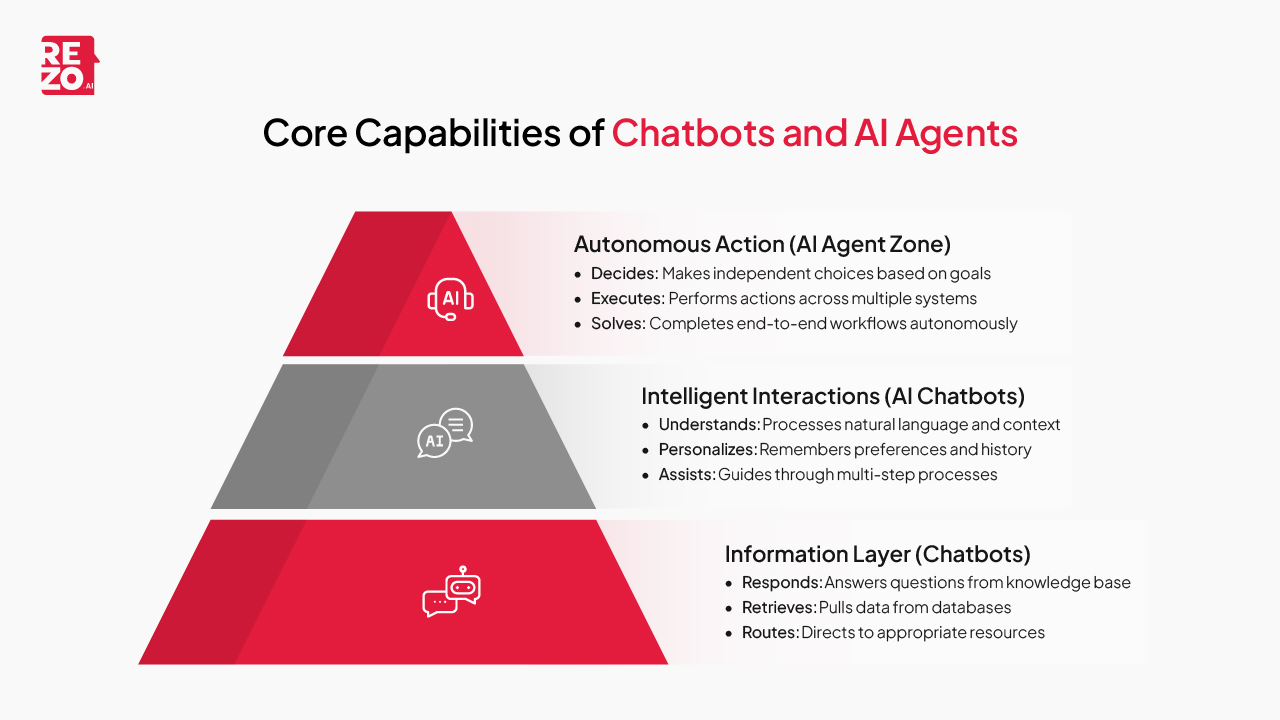
Conclusion
The difference between AI agents and chatbots isn’t semantic, it’s fundamental. Chatbots talk; AI agents act. Chatbots respond; AI agents solve. Chatbots follow scripts; AI agents follow reasoning process.
But there’s no universal “better” choice. The right technology depends on your specific use cases, technical maturity, internal and external resource availability, and business objectives. For many organizations, the optimal approach combines both: chatbots to automate repetitive tasks while AI agents tackle complexity, all augmenting skilled human agents who focus on relationship-building and nuanced problem-solving.
As a CX leader, your strategic advantage comes not from choosing the best AI chatbot software or AI technologies but from thoughtfully matching capabilities to requirements. Start with clear assessment of your customer service operations, identify where automation delivers the greatest impact, and build implementation roadmaps that balance quick wins with long-term transformation.
The customer service landscape is evolving rapidly, with multiple agents representing the next frontier in automation capability. The question isn’t whether to adopt these technologies but how to implement them strategically to deliver better experiences, improved efficiency, and measurable business results.
Ready to explore how agentic AI can transform your customer service operations? The conversation starts with understanding your specific needs and matching them to the right mix of technologies. A conversation worth having as customer expectations continue to rise and operational efficiency becomes increasingly.
Frequently Asked Questions
What are the different types of chatbots?
The different types of chatbots are: Rule-based chatbots, AI-powered chatbots, Generative AI chatbots and Conversational AI chatbots.
What is the core difference between an AI agent and a chatbot?
An AI agent can operate independently without human intervention. It is proactive and autonomous, going beyond simply responding to customer queries. In contrast, chatbots are rule-based with predefined scripts and responses. They are reactive in nature and can only reply to customer queries within their set rules..
How can enterprises find the right chatbots?
For enterprises handling large volumes of customer queries, it is better to opt for AI-powered chatbots or AI agents. Rezo AI’s chatbots are built specifically for enterprise needs, delivering omnichannel and hyper-personalised customer experiences for your users.
Frequently Asked Questions (FAQs)

Take the leap towards innovation with Rezo.ai
Get started now














